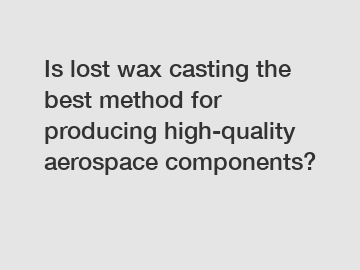Is lost wax casting the best method for producing high-quality aerospace components?
Lost wax casting, also known as investment casting, has been a popular method for producing high-quality aerospace components for many years. This technique involves creating a wax pattern of the desired part, encasing it in a ceramic shell, burning out the wax to leave a cavity, and then pouring molten metal into the cavity to produce the final part. While lost wax casting has its advantages, it may not always be the best method for every aerospace component. In this article, we will explore the benefits and limitations of lost wax casting in producing high-quality aerospace components.
Benefits of Lost Wax Casting in Aerospace Components.
One of the key advantages of lost wax casting in aerospace is its ability to produce complex and intricate parts with high precision. The process allows for the creation of parts with thin walls, intricate geometries, and fine details that may be difficult or impossible to achieve with other manufacturing methods. This is particularly important in aerospace, where components often have complex shapes and tight tolerances.

Another benefit of lost wax casting is its ability to produce parts with a smooth surface finish. Because the wax pattern is used to create the mold, the final part often requires minimal finishing or machining, resulting in a part with a high-quality surface finish. This is important in aerospace, where surface finish can be critical to the performance of the part.
Limitations of Lost Wax Casting in Aerospace Components.
While lost wax casting has many benefits, it also has some limitations that may make it less suitable for certain aerospace components. One of the main limitations is the cost and time involved in the process. Lost wax casting can be a time-consuming and labor-intensive process, involving multiple steps such as creating the wax pattern, building the ceramic shell, and pouring the metal. This can result in longer lead times and higher production costs compared to other manufacturing methods.
Another limitation of lost wax casting is its ability to produce large parts. While the process is well-suited for small to medium-sized components, it may not be the best choice for producing larger parts due to the size limitations of the molds and equipment used in the process. For larger aerospace components, other manufacturing methods such as machining or forging may be more suitable.
Conclusion.
In conclusion, lost wax casting can be an excellent method for producing high-quality aerospace components, particularly for small to medium-sized parts with complex geometries and tight tolerances. The process allows for the production of parts with high precision and a smooth surface finish, making it ideal for many aerospace applications. However, it's important to consider the limitations of lost wax casting, such as cost, time, and size constraints, when determining the best manufacturing method for a specific aerospace component. In some cases, other manufacturing methods may be more suitable for producing certain aerospace components. Ultimately, the choice of manufacturing method will depend on the specific requirements of the part and the desired outcome.
Contact us.
If you have any questions about lost wax casting or if you're interested in using this method for producing aerospace components, please don't hesitate to contact us. Our team of experts is here to help and can provide guidance on the best manufacturing method for your specific needs.
For more information, please visit Lost wax casting for HVAC equipment parts, lost wax casting water pump impeller, lost wax casting water pump impeller.
218
0
0

Comments
All Comments (0)